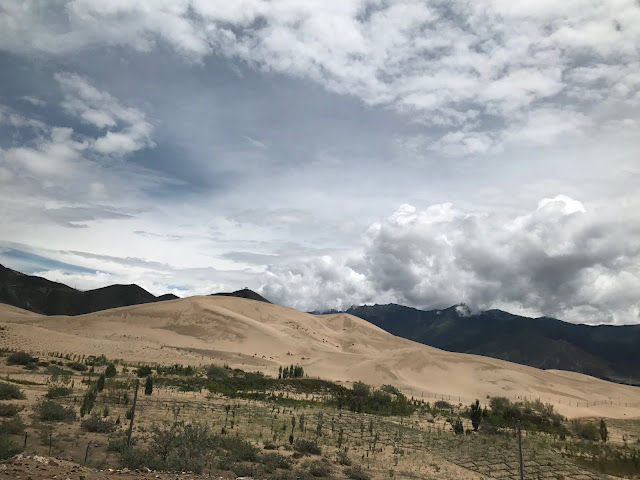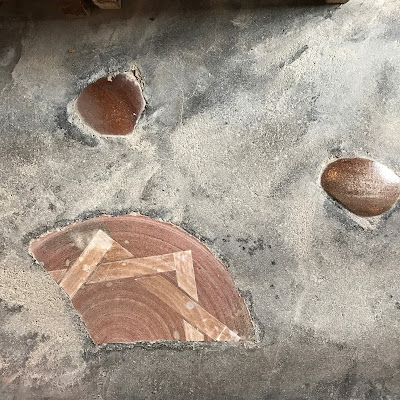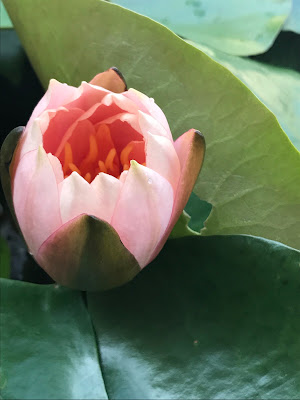How will I honor the Tibetans and their practice? What can I do?
I’m just one person.
Ichi-go, ichi-e is a Japanese saying that translates to one chance in a lifetime or one encounter in time, not to be replicated. I try to remember how precious, unique and sacred one encounter can be. This phrase carries meaning as I reflect upon my glimpse into Tibetan culture, history and people I've respected from afar for decades and who occupy a significant place in my heart. I realized soon after arriving in Lhasa, Tibet that it would be impossible not to look and see the occupation, oppression, domination of the Tibetan people by the Chinese government. What was I going to do with the conditions, privilege that brought me here? How was I being complicit by taking non-action? Bearing witness and telling what I saw to whomever will listen is my first responsibility.
 |
Sweet smoky cypress imbued the air igniting my senses.
 |
Standing amidst thousands of Tibetan prayer flags near a 17,000 foot summit, I felt the power of wind flow through me. Prayer flags adorn the landscape and carry sutras, Buddhsit scriptures on the wind in the ten directions. Each flag represents an element of nature red-fire,white-air/wind, blue-sky, yellow-earth, green-water.
 |
| Sheer determination in the steps and prostrations of devoted pilgrims impels me to speak up. |
Have you ever witnessed an injustice by a group who uses power, intimidation, imprisonment over another? Have you ever felt paralyzed from your natural desire to stand up to injustice because the heat of fear rose up
in your body? I witnessed a people disrespected and intimidated by a powerful force. This is a personal account of facing fear for my safety while standing up for the Tibetan people-people I've not often seen in major media. As an American, I am most familiar with exiled Tibetans forced to leave their country for India, Nepal, U.S. and Europe. Rarely have I had the chance to know what Tibet is like for Tibetans.
I’m compelled to tell what I saw because I made
a promise, a vow to myself not to forget the devotional people of Tibet I met. I witnessed a practice of Buddhism steeped in ritual and devotion of over 1000 years that deserves to be told. I hope to convey an account of how I was inspired and why it left an indelible mark on my heart. I
need to tell what I saw to honor the Tibetan people residing in Tibet.
Standing up amidst fear for my safety and for that of my traveling companions.
Central to the Dharma, Buddhist teachings, is the 8 Fold Noble path, often the entry point is skillful or wise understanding. Near to my heart was the Bodhisattva Vow to end the suffering of all beings.
I consider Tibetan Buddhists my siblings on a path. We are interconnected. I felt a deep kinship toward family members wanting to fully practice the traditions that have been a part of their daily lives for over a millenia. Growing questions and uneasiness arose each day toward the Chinese government that occupies Tibet. The historic places we were fortunate to see felt like a police-state surrounded by breathtaking landscape, amidst modern hotels and comfortable amenities and I was perpetually on alert.
Will I be awake or asleep to the injustice, oppression and discrimination?
I consider Tibetan Buddhists my siblings on a path. We are interconnected. I felt a deep kinship toward family members wanting to fully practice the traditions that have been a part of their daily lives for over a millenia. Growing questions and uneasiness arose each day toward the Chinese government that occupies Tibet. The historic places we were fortunate to see felt like a police-state surrounded by breathtaking landscape, amidst modern hotels and comfortable amenities and I was perpetually on alert.
Will I be awake or asleep to the injustice, oppression and discrimination?
It became clear that I was bearing witness in real-time to injustice, oppression and surveillance not experienced by many Americans. It became clear, as I gave up my passport daily, in the unspoken uneasiness of my companions and at police checkpoints, that surveillance was a way of life here. As a seasoned traveler, I keep my passport with me. I was aware of my discomfort several times a day when it was surrendered.
We bear witness to special occasions, celebrations and sometimes accidents and crimes. We bear witness to remember the truth. This is my testimony of what I witnessed. It would have been easy to be mesmerized by the dream-like landscape of Tibet but it would be unconscionable to be unconscious to the vast injustice witnessed in this occupied country.
I will never forget you.

We bear witness to special occasions, celebrations and sometimes accidents and crimes. We bear witness to remember the truth. This is my testimony of what I witnessed. It would have been easy to be mesmerized by the dream-like landscape of Tibet but it would be unconscionable to be unconscious to the vast injustice witnessed in this occupied country.
I will never forget you.

 There are restrictions to the auspicious spirtitual sites where Tibetans can pray, there is intimidation in the overwhelming police presence, seen and unseen. There is an oppressive nature in the lack of Tibetan language I witnessed in local shops, hotels and cafes. The language I noticed was Mandarin. It seemed like the Tibetan language and culture was endangered. Empathy, compassion and
a sense of needing to speak up awakened in me.
There are restrictions to the auspicious spirtitual sites where Tibetans can pray, there is intimidation in the overwhelming police presence, seen and unseen. There is an oppressive nature in the lack of Tibetan language I witnessed in local shops, hotels and cafes. The language I noticed was Mandarin. It seemed like the Tibetan language and culture was endangered. Empathy, compassion and
a sense of needing to speak up awakened in me.
When I think of the term compassion, His Holiness Dalai Lama is who I envision. He is
the spiritual leader of one of four major branches of Tibetan Buddhism, called Gelug or Geluk. He is revered by the Tibetan people.
It’s illegal to have a photo of the Dalai Lama in your car, in one's home, in one's wallet. Citizens and tourists can be intimidated, beaten, or jailed by local authorities for possessing his photograph.
It’s illegal to have a photo of the Dalai Lama in your car, in one's home, in one's wallet. Citizens and tourists can be intimidated, beaten, or jailed by local authorities for possessing his photograph.
A few times I attempted to explain that there are Tibetan Buddhists practicing in the U.S. It was difficult to convey the thousands of Tibetan Buddhists in the west. Censorship blocks social media so there were no easy ways to share the many scholars, monasteries, monastics, temples, that have been cultivating for decades outside of Tibet. Shop owners in small towns thought it funny to see westerners wanting to purchase prayer flags in monastery stores. Propaganda is so strong that the Chinese invasion of Tibet during the cultural revolution is taught as “liberation”. Some believe China freed the Tibetan people from slavery under the Dalai Lama. Hundreds of monasteries were desecrated and destoryed during the cultural revolution. Potala Palace, the winter palace of the Dalai Lama is a magnificent testament to the significance of the Dalai Lama lineage. It's iconic architecture, 1000 rooms of art, thankgas, sculpture and chapels exudes an emptiness, not expressing its full potential to serve a nation of devotional Buddhists. Today, thousands of tourists visit each day. The weight of heavy security, seen and unseen, is felt all over.
 |
| A celebration we stumbled upon Samye Monastery, uniformed police always present, top left. |
 |
| Lamas, Tibetan leaders at Samye founded around 795 C.E. |
 |
| View from Yongbulakang Palace |
 |
| Nomadic camp. |
I will never forget you.
Dear Sisters and Brothers in Tibet,
Please know that your ways of practice have been carried over the Himalayas. For many decades, we have cared deeply and study your traditions with deep reverence. Powerful winds continue to carry the sutras across nations and oceans.
Your spirit can't be suppressed. Your long tradition of Buddhism is too enduring and buoyant to be captured, possessed, or erased. Like clouds shape shifting across the expansive Tibetan sky, your customs are swept across the globe to inform and inspire living beings in countless nations.
Please do not be dispirited. Please do not lose hope. There are thousands of earnest practicioners who respect your traditons. Many beings benefit from your practice. You have touched numberless hearts.
I will continue to tell the story of what I witnessed.
No one can stop the wind.
With love and deep compassion,
Your sister
 |
| Jokhang Temple in Barkhor Square. Police on rooftops, rappelling down the buidling at the top first and fourth windows. |
The next time you see Tibetan prayer flags, please remember the Tibetans living in Tibet. Remember their determination and devotion under some of the harshest conditions. Many are still imprisoned and tortured. Prayer flags are a part of our culture now, in part because of the Tibetans both inside and outside of Tibet. Sutras are not the only messages on the flags as they flow in the wind. So too, does the essence of a people.
Bodhisattva Vow
May I be a protector to those without protection,
A leader for those who journey
And a boat, a bridge, a passage
For those desiring a further shore.
May the pain of every living creature
Be completely cleared away.
May I be the doctor and the medicine
And may I be the nurse
For all sick beings in the world
Until everyone is healed. -Shantideva
To learn more:
http://www.nytimes.com/2012/12/13/opinion/tibet-is-burning.html
https://freetibet.org/about/travel-guide
https://www.dalailama.com/
(https://tricycle.org/magazine/noble-eightfold-path/)















































